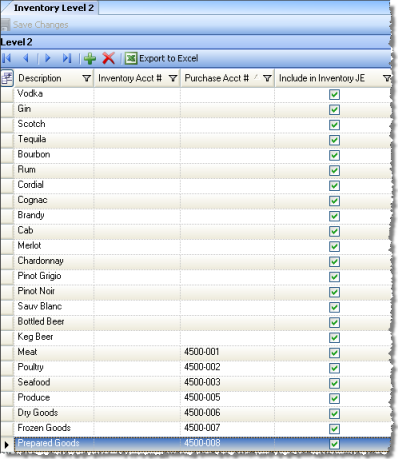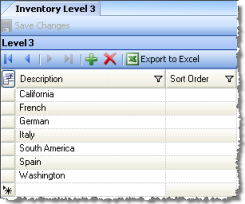
Before you can begin setting up your Master Inventory list, you will need to set up your Inventory Levels in Compeat. Inventory Levels are global so they apply to all entities in the enterprise and any edits made will be applied to all entities.
Compeat supports up to three Inventory Levels by which to group your inventory items. You can create as many Inventory Level groupings as you need to classify your inventory items.
How you set up Inventory Level 1 and Level 2 (a sub-set of Level 1) groupings will determine the way you code the items you purchase (for expensing purposes), what groups show up as cost of goods sold (COGS) lines on your Profit & Loss statements (P & L) and what groups of items are shown on your Inventory JEs.
Inventory Levels determine how you can group items when running certain inventory reports. For instance, after performing a physical count of your inventory, you can print a report that is grouped by Inventory Levels. The report gives you the ending inventory information that will be used to make your inventory journal entry in the Inventory JE screen.
In short, the Inventory Levels you setup will be the foundation of your inventory database.
As an example of inventory level hierarchy, you may inventory Chardonnay wine, which might be classified as follows:
Level 1: Wine
Level 2: Chardonnay
Level 3: California
Once you have completed your Inventory Levels setup, you will assign the correct Levels to each item you setup in the Master Inventory Item list. All Master Inventory Items and all Prep Items you set up must be assigned at least to an Inventory Level 1 category or they will not save. Inventory Levels cannot be deleted if they have Inventory items or Prep Items assigned to them.
To insure that you will be able to get inventory reports that include all food items, we recommend setting up a Level 1 group to represent all food items. Then you can use Level 2 to reflect the food sub-sets that you wish to report COGS for on the P & L.
While all companies have their own reporting needs, the example below would be a fairly typical Level 1 setup. Note that some of the Inventory Level 1 groups in this sample are using the same account (the Purchase GL account #) in both the Inventory Acct # field and the Purchase Acct # field. These groups are for items (such as paper goods, china, etc.) that we do not want to inventory for value, but that we do want to order, expense correctly on AP invoices, and get purchasing history reports on. Compeat requires that we enter an account in both fields at Level 1, so we use the purchase account in the inventory account field. Note also, that for the non-inventoried groups, we uncheck the "Include in Inventory JE" box so that these groups will not show up on our inventory journal entry (see below for further explanation of the "Include in Inventory JE" box).
The inventory item level 1 screen appears similar to the following:

Description of fields:
Description Enter the name of the group you wish to create; this will appear as a grouping option on reports.
Inventory Account # Assign the General Ledger Inventory account used for valuing items belonging to the group you are describing. If the group will not be inventoried, you can use the Purchase Acct in this field. This is a required field at Level 1 only.
Purchase Account # Assign the General Ledger Purchase account (also known as Expense or COGS account) number used for expensing items belonging to the group you are describing. This is a required field at Level 1 only.
Waste Account # The account number that is debited to record inventory designated as waste. When a waste quantity is posted on the Waste/Donations screen, a journal entry is made debiting the waste account and crediting the purchase account as defined in that item's inventory level 2 definition (using level 1 if a level 2 definition does not exist). This is required only if you will be using the Waste/Donations feature.
Donations Account # The account number that is debited to record inventory designated as donations. When a donations quantity is posted on the Waste/Donations screen, a journal entry is made debiting the donations account and crediting the purchase account as defined in that item's inventory level 2 definition (using level 1 if a level 2 definition does not exist). This is required only if you will be using the Waste/Donations feature.
Std. Cost
Var. Acct # If you wish to use standard costs for some of your
inventory items, you will have the option of defining
Standard Costs for inventory items so you can run your inventory
reports using standard costs, while still reflecting actual COGS for
reporting. When expensing for standard cost items, the difference
between the standard cost (user specified) and the actual cost of
an item will post to the Standard Cost Variance (COGS) account specified
in the this field. Unlike regular inventory costs, standard cost items
are never updated by the system; they can only be changed manually.
This is required only if you will use standard costing.
![]() Visit the Compeat
Support Website for additional information on this topic and more.
Visit the Compeat
Support Website for additional information on this topic and more.
Sort Order Determines the order this level will appear in reports, relative to other level 1 or level 2 definitions. If no sort orders are defined, reports will display in alphabetical order. If you omit some sort orders, and specify others, those levels without sort orders will be displayed first in alphabetical order, followed by the rest of the levels in sort order.
Commissary Inside/Outside Profit Acct # When shipping an Inside or Outside commissary order, the profit dollars for each item (difference between actual item cost and selling price/markup) will be credited to this account. If a valid profit account is found on inventory level 2, that one will be used. Otherwise, the profit account from level 1 will be used. This field is only necessary when setting up a Commissary entity in Compeat.
Commissary Inside/Outside COGS Acct # The actual cost of each item is credited to this account when an Inside or Outside commissary order is shipped. If a valid COGS account is found on inventory level 2, that one will be used. Otherwise, the COGS account from level 1 will be used. This field is only necessary when setting up a Commissary entity in Compeat.
Sales Acct Filter Select the GL Account Filter for the corresponding inventory level 1 category. GL Account Filters are setup under Setup > GL Account Filters. If, for example, you have a Level 1 Food, a GL Account Filter for Food Sales may be applied here. This will determine how to calculate cost of goods sold on the Cost of Goods report.
Include in Inventory JE Uncheck this box to exclude this level definition from the journal entries that result from Valuation Counts. The only value, then, of counting an item in an unchecked level definition would be to update the theoretical quantity on hand for ordering purposes. Unchecked level definitions will appear at the back of the Inventory Count Pre-Post report, and will display quantities entered, but without costs.
Allow Back Orders Unchecking this box will prevent any item in the level from being back ordered.
There are two types of Level 2 groups. One is the Level 2 group you can create for use in financial reporting as well as for use in inventory reports (see the sub-groups of Food illustrated below). Note that in the example below, the Food subgroups (meat, dairy, produce, etc.) all have a separate Purchase Acct # designated. This will allow items belonging to these Level 2 groups to be expensed separately on AP. Thus, Level 2 groups with Purchase Acct #s assigned will show up as separate lines on the P & L (as result of their individual expense accounts).
The other type is the Level 2 group you can create to use for inventory reports but you do not wish to see broken out separately on the P & L statement. The Level 2 Groups without a Purchase Acct # assigned will not show up as separate groups for financial reporting, but as a result of the grouping, you will be able to pull up inventory reports by these groupings. Items belonging to Level 2 sub-sets that do not have a Purchase Acct # assigned will be expensed to their correct Level 1 Purchase Acct #. For example, Scotch will be coded to the Purchase Acct # for Level 1, Liquor.
The inventory value of all items belonging to Levels where the "Include in Inventory JE" box is checked will be included in the journal entry created when a valuation count is posted. If "Include in Inventory JE" is unchecked, the group will not be included in journal entries that result from Valuation Counts. The only value then, of counting items in an unchecked Inventory Level would be to update the theoretical quantity on-hand for ordering purposes. Unchecked Inventory Level groups will appear at the back of the Inventory Count Pre-Post report (when sorted by Level), and will display quantities entered, but without costs.
The inventory value for items belonging to the Level 2 groups of items that do not have a Purchase Acct assigned will go to the appropriate Level 1 account (i.e., in the example below, all of the Vodka, Gin, etc., will be credited to the Liquor account. The value for items belonging to the Level 2 groups that do have a purchase account assigned will credited to the various Level 2 GL accounts (i.e., in the example below, the value of Meat, Poultry, Seafood, Produce, etc.,will be credited to the appropriate corresponding accounts).
The Inventory Level 2 screen appears similar to the following:

The available fields are similar to those described for Inventory Level 1.
Inventory Level 3 can be set up to further break down Level 1 and 2 groupings for inventory related reports. Notice that there are no fields at Level 3 by which to assign GL expense or inventory accounts. Level 3 groupings are not intended for use in financial reporting.
The screen appears similar to the following:

Enter a description for the level. Optionally, also specify a sort order that determines the order this level will appear on reports, relative to other level 3 definitions. If no sort orders are defined, reports will display the levels in alphabetical order. If you omit some sort orders, and specify others, the levels without sort orders will be displayed first, in alphabetical order, followed by the rest of the levels in sort order.